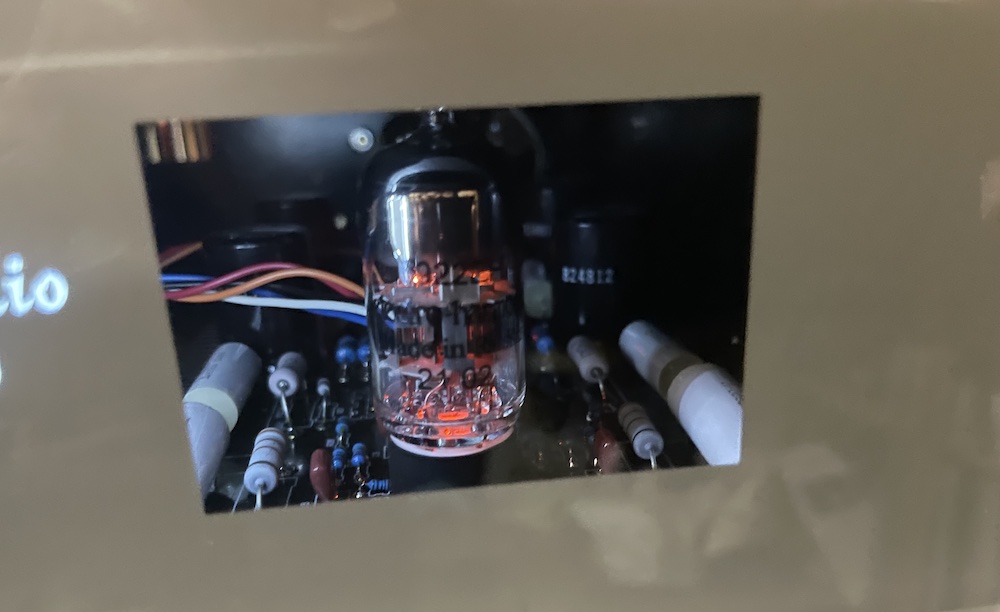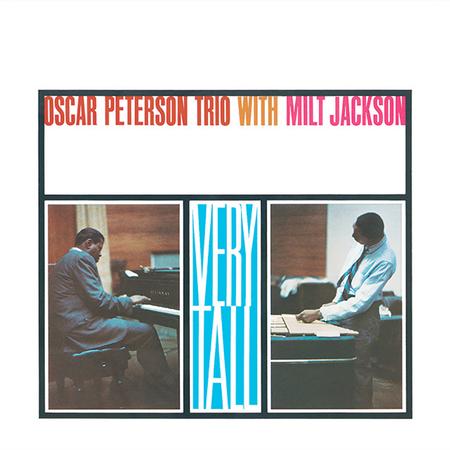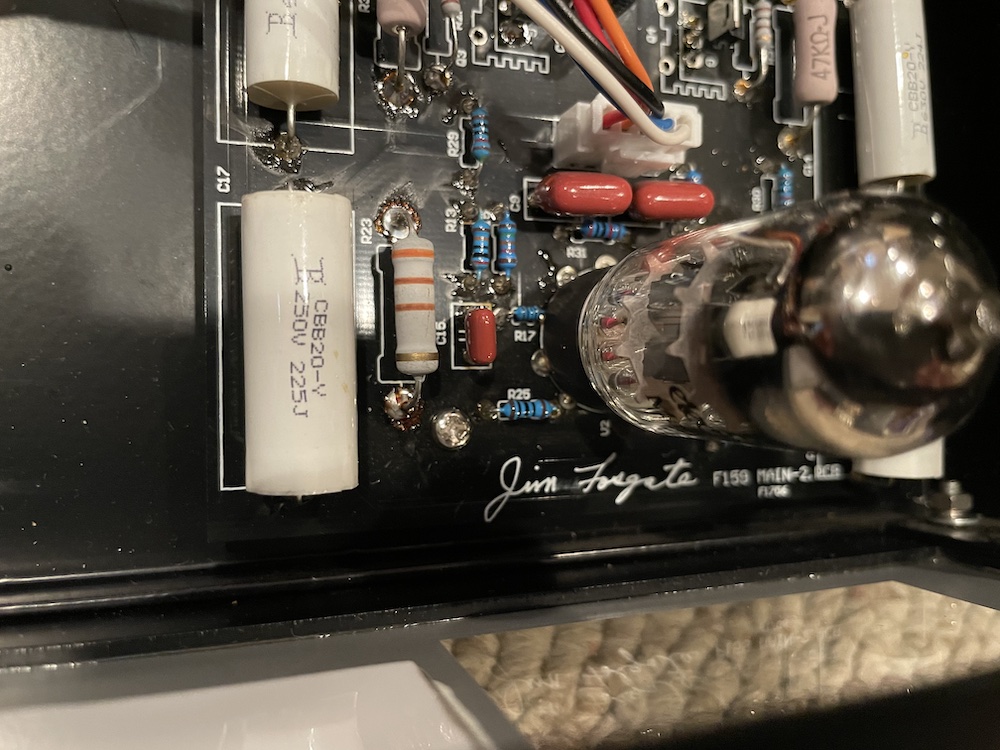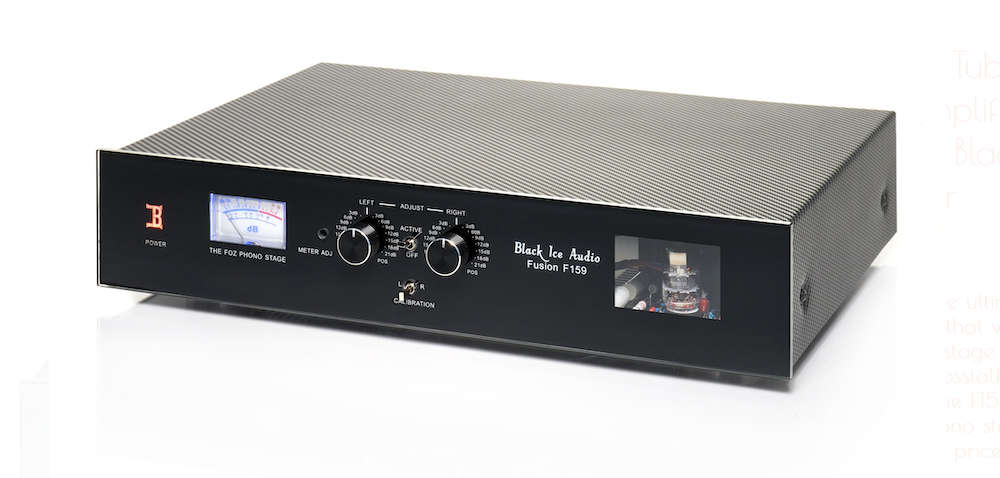The Black Ice Audio F159 Tube/MOSFET Phono Preamplifier With XT-R Crosstalk Reduction Circuit
feature packed, great-sounding Jim Fosgate designed phono preamp
Maryland-based Black Ice Audio manufactures and markets an extensive line of vacuum tube-based audio products. The company had a long association with the late audio genius Jim Fosgate, who passed away in 2022.
Rather than list Jim’s accomplishments here, please read his obit, though if you don’t, just know that among his many tech accomplishments Jim invented and licensed to Dolby what became Dolby Pro Logic II. It made him a well-deserved wealthy man, but it didn’t stop him from continuing his quest for great stereo sound.
Fosgate also designed the familiar “Fozgometer” for setting phono cartridge azimuth. The FusionF159 phono stage is among the products he developed for Black Ice. The number refers to how many iterations of the phonostage he produced until he was satisfied with the design.
The history of Black Ice Audio is worth the read as is the company’s “where we are made” page but in case you are not interested in doing that either, you should know this: Black Ice is related to Jolida, a company with which many of you are familiar. Black Ice products are manufactured at a Shanghai, China factory that it owns, which is very unusual. It does not use an OEM for its products. It is the OEM. Black Ice engineering, final assembly and QC is done in Maryland.
All of this helps explain how Black Ice can sell the hybrid tube/MOSFET solid state F159 for $1875.00. Housed in a Heli-arc welded chassis, the F159 uses a pair of 6922/6DJ8 in the input stage (visible in the front window) and MOSFETs on the output. Should you choose, you can replace the pair of factory-installed Tung Sol NOS 6922s with a supplied pair of Chinese 6DJ8s.

 A rear panel gain switch toggles between 39dB and 59dB, meaning the F159 is useable with MM, high output MC and low output MCs with approximately .5mV or higher output.
A rear panel gain switch toggles between 39dB and 59dB, meaning the F159 is useable with MM, high output MC and low output MCs with approximately .5mV or higher output.
Also on the rear panel are sets of RCA input and output jacks as well as a three-position loading switch. One position sets the standard 47kOhm MM load, another provides 30kOhms, which is more appropriate for some MM cartridges, while the third position engages a rear panel potentiometer for MC loading that lets you smoothly adjust between 10 and 1kOhms. There’s also a master “on/off” switch above the IEC A.C. jack as well as a large banana-plug friendly ground lug.
An iteration of Fosgate’s Fozgometer—the XT-R— is built into the F159. As with the Fozgometer, its purpose is to reduce crosstalk. But unlike the Fozgometer, the XT-R (crosstalk reduction) does not require physical azimuth adjustment, which means if your tonearm doesn’t offer azimuth adjustability (all Rega arms, for instance), the XT-R can accomplish it electronically.
The F159’s front panel includes a touch-sensitive “touch the logo” power “on/off” switch, the aforementioned tube viewing window, the L/R XT-R adjustment knobs and toggle switches and an illuminated dual VU meter plus a meter calibration adjustment screw.
 Removing the wrap-around cover reveals on one side of the chassis a shielded power transformer in its own case, well-separated from the neatly laid-out signal processing circuitry on the other side. In between is another circuit board containing the solid-state rectification and other power supply components. The XT-R board resides behind the from panel.
Removing the wrap-around cover reveals on one side of the chassis a shielded power transformer in its own case, well-separated from the neatly laid-out signal processing circuitry on the other side. In between is another circuit board containing the solid-state rectification and other power supply components. The XT-R board resides behind the from panel.
 Set-Up and Use
Set-Up and Use
Setting up the F159 is easy and not in need of description, but if you’re using a moving magnet cartridge be sure to try both loading options. 47kOhms is really a “non-standard” standard adopted by the industry to keep things simple and some MM cartridges like the now discontinued Shure M97xE produce flatter response loaded at around 30kOhms—or so I’ve been told.
What’s somewhat concerning is not only a lack of capacitive loading options but no specification for what the fixed capacitance load is. I’ll assume it’s around 100pF because obviously Jim Fosgate knew what he was doing and the Rega Exact that I used with it sounded open and linear. Still, it would be nice to see it noted in the specs.
First I listened with the XT-R out of the circuit and then in, using the original pressing of Keith Jarrett Solo-Concerts Bremen Lausanne (ECM-3-1035/37 ST) as described in the Rega Planar 3 50th Anniversary turntable review . Using the XT-R feature is like using a Fozgometer. You use a good test record like the Analogue Productions Ultimate Test Record that includes test bands with a 1kHz tone on only the left channel and then only on the right. By the way, these test records are only as good as the cutting engineer and the lathe set up. WallyTools’ J.R. Boisclair has examined a stack of test records and found seriously “off” cutting styli azimuths (among other issues). If you use a bad test record to set azimuth, you’ll optimize it for that test record and probably little else! Fortunately, the AP test record’s azimuth set up was well-accomplished and it’s a reliable test record.
You play the left channel only test track, and with the XT-R circuit toggled to “active” and the channel selection set to “L” the meter reads the right channel. Ideally you'd see no meter jump meaning zero crosstalk but that's never the case. You adjust the left knob to minimize the right channel’s output (the crosstalk). Then you repeat the procedure using the right channel test track and minimize left channel crosstalk.
By toggling the XT-R “on and off” you can instantly hear the sonic differences produced by minimizing crosstalk. Of course, engaging XT-R produces a wider and more coherent soundstage, but it also helped produce greater soundstage depth and image three-dimensionality. With the XT-R engaged piano image on the Jarrett record was somewhat pushed back on the stage and the sense of space appeared behind the piano. Attack-coherence was also improved. It was slightly less “tinkly” and more full-bodied.
Wider, more coherent stage, improved image specificity and greater sense of depth are observations everyone has experience who’s carefully set azimuth electrically as opposed to “put a mirror on the platter and adjust for cantilever perpendicularity”.
This feature lets those who own tonearms incapable of adjusting azimuth to correct for this cartridge build imperfection. Toggling it on and off before correction produced no discernible sonic differences. In other words, no sonic price paid for the feature, whether you care to use it or not.
Touch of Warmth
With the Tung-Sol 6922 tubes in place (as delivered) rather than the described as “warm sounding” 6DJ8s, you’d be hard-pressed to say for sure that tubes of any kind were part of the circuitry. The single tube at the front-end of each channel adds a pleasing “kiss of warmth” to the mid to upper octaves, without burdening the bottom ones with “soft and warm”. Bass transients were “snappy”, articulate, and cleanly presented. Backgrounds, even on quiet recordings and passages were quiet and free of “tube rush” or a gauzy overlay.
MOSFETs generally have a warner more “tube-like” sonic signature than do bi-polar devices—particularly in the midrange— so perhaps that accounts for the coherence of the tube/solid-state sound here but I’m more inclined to credit it to Jim Fosgate’s engineering expertise rather than to the choice of output device.
The Lyra Atlas Lambda SL installed on the OMA K3 was a bit low in output (.2mV) for the F159’s 59dB gain but I’d recently installed the EMT 928 II turntable fitted with an EMT 909-HI arm and JSD Pure cartridge, which has a generous 1.05mV output with a recommended 200-300 Ω recommended load and the results were uncommonly good considering the modestly priced phono pre paired with a $15,000 turntable/arm combo and $4495 cartridge.
I’ve just moved my Black Saint/Soul Note collection to a more easily accessible shelf and as expected have been playing more of them. A great one is Threesome featuring Monty Alexander, N.H. Orsted Pedersen and Grady Tate (Soul Note SN 1152). Jacob Heilbrunn played it for me at his place and I immediately went on Discogs and ordered a copy. When I got home and checked the BS/SN stash, I already had a copy. Oh, well. That's a good reason to put your whole collection on Discogs but who has time? The rich BS/SN catalog is in serious need of a reissue program!
Deep, firm, plugged-in (or tightly mic’d) bass lines, Tate’s articulate stick work and Alexander’s strong, well-defined attack put the F159 to the transient test, which it easily passed. Bass lines were tight, muscular and if not as fully extended as through the CH Precision P10, were powerful enough! Tate’s cymbals chimed brightly with sharp, well-defined metallic precision and Pedersen’s bass had rhythmic swagger and texture to spare—all against a black backdrop and all for $1875.
One of the great high performance audio pleasures is hearing a good system reproducing vibes. The bell should ring nicely but there should be warmth too, caressing each mallet strike.
Analogue Productions recently reissued Very Tall (Verve V6-8428/B0037378-01) featuring Milt Jackson and the Oscar Peterson Trio—then the “classic” Ray Brown, Ed Thigpen, Peterson grouping.
 I’d bought a copy when it was first issued in 1962. It was the first time I got to hear Milt Jackson outside of the Modern Jazz Quartet.
I’d bought a copy when it was first issued in 1962. It was the first time I got to hear Milt Jackson outside of the Modern Jazz Quartet.
Somehow I’d gotten the Peterson Trio’s West Side Story (V6- 8454) earlier and on it Peterson takes a seriously aggressive swipe at the Bernstein score. I wondered how Peterson would pair with the cool, laid back Milt Jackson.
No problem! Very Tall is a relaxed, clearly commercially oriented set—nothing exotic, but it swings like hell far more so than did the staid, cool MJQ and Peterson plays it cool. Not John Lewis cool, but sufficiently cool to mesh well with Jackson.
The F159 did a really fine job conveying the mallet strike’s delicacy, the clean bell-like shimmer and the warm decay overtones. “Work Song” gives the trio a chance to play aggressively and hit some dynamic peaks playing off the song’s structure. The F159 effectively conveys the trio’s “punch” but misses a bit of the slam, but we’re talking $1875 not $18,075 (or $76,000)!
Conclusion
I kept the F159 in my system for many months and it was as reliable as it was a strong sonic performer. It was easy to forget it was working well in the context of a high-performance system and not calling attention to any notable shortcomings.
Add its strong feature set—the tubes, which you are free to roll to arrive at your preferred sonic signature—and the XT-R azimuth adjustment system, plus quiet, and impressive detail resolution (despite the taut, rhythmically snappy performance there’s zero negative feedback in the tube circuit), with not a grain of unpleasant edge or etch, plus a 5 year limited parts and labor warranty, and you have a strong contender for a top under $2000 phono preamp choice.
 The website doesn't state it explicitly but Black Ice Audio also appears to also be a retail operation.
The website doesn't state it explicitly but Black Ice Audio also appears to also be a retail operation.
Specifications
SPECIFICATIONS
Gain: @ 1KHZ in low gain position 39DB with 47K input
Gain: @ 1KHZ in high gain position 59DB with 47K input
Input Resistance: Variable from 10 ohms to 1k ohms, 30K ohms, 47K ohms
Output Impedance: 105 ohms
Noise Floor: In high gain position approx. -70 DB with input load set to 10 ohms, the noise floor will be lower with the gain set in low position.
Frequency Response: RIAA EQ is Plus/Minus 1/4 DB from 250 HZ to 20KHZ, + 3DB at 20 HZ (Bass Boost)
Distortion:.05% @ 1 kHz 1V RMS out
Plate Voltages: Approx. 90V on the input stage, 70V on the second stage.
Output Impedance: 32 to 300 ohms
SNR: 85dB
Tube Complement: 2 x 6922/6DJ8
Power Requirements: 110V-120 VAC 60Hz or 220-240 VAC 50Hz
Dimensions: 17 inches wide by 12 inches deep by 4 inches high
Weight: 16 pounds (7.26 Kg) net, approximately 21 pounds (9.53 Kg) packaged
Warranty: 5 year limited parts and labor. 1 year or 1000 hours whichever comes first on Black Ice Audio Tubes.
Fuse: 110 - 120 VAC, 1 Amp Slow Blow; 200 - 240 VAC, .5 Amp Slow Blow Size 5mm X 20mm
INCLUDED IN THE BOX
Fusion F159 Phono Stage
4 Pre-amp Tubes: 2 x 6922 / 2 x 6DJ8
Black Ice Test Record (review sample didn't include the record)
Textured Gloves
Power Cord
Dust Cover Bag
Manufacturer Information
21310 Ridgecroft Drive
Brookeville, MD 20833
info@blackiceaudio.com
(301) 953-2014










































.png)








